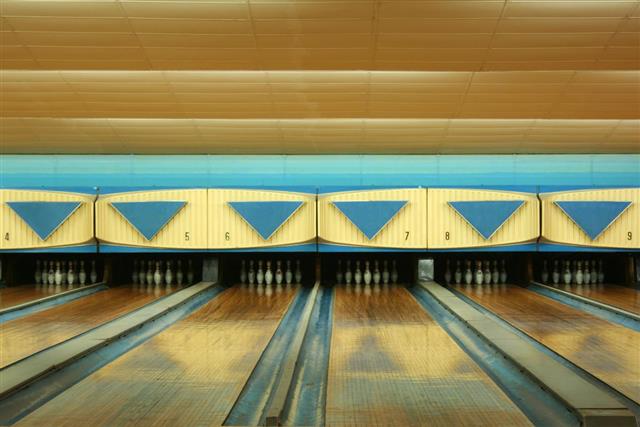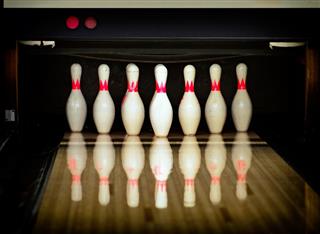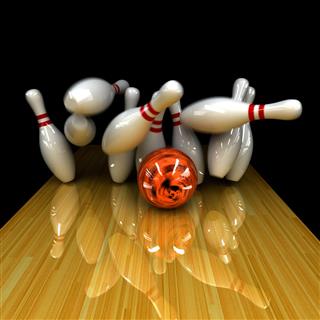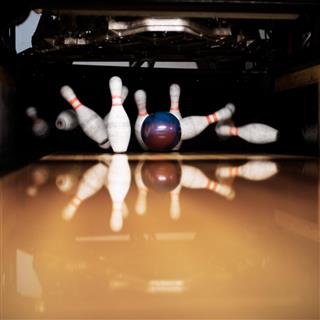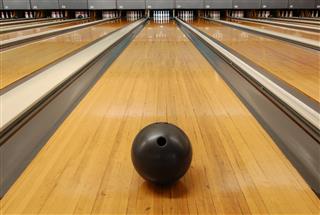
In order to get better in bowling, apart from perfecting the game, you should also understand its terminologies. Read the SportsAspire article to find definitions of different bowling terms used.
A ten-pin bowling, more popularly known as bowling, is a competitive sport. The game involves bowlers to roll a bowling ball down a wooden lane. At the end of the lane are 10 pins, lined in a triangular shape, some lined behind each other, which need to be knocked down. The player scores according to the number of pins that are knocked out of the way. There are 10 frames, and each player gets two turns per frame to clear all the pins.
Bowling Terminologies and Definitions
Address
A bowler’s initial position.
Alley
Surface of the lanes which is made of maple, pine, or urethane boards.
All the Way
Finishing a game with only strikes.
Anchor
The last participant to bowl in a team competition.
Angle
The direction taken by the ball while traveling into the 1―3 pocket for right hand bowlers, 1―2 for left hand bowlers.
Approach
Portion of the lane (path) from the back of the ball return area to the foul line.
Armswing
The entire arm movement, from the arc of your bowling arm (right or left) and hand from the initial move toward the line till the ball is released over that line.
Baby Ball
Throwing or releasing the ball too delicately or carefully.
Back Ends
The final 6 feet of the lane.
Backup
A ball that falls to the right side for right-handed bowlers and left side for left-handed bowlers.
Balk
Interfering to stop or mess up some other bowler’s normal actions.
Ball Rack
The rack used to store balls or where the balls returns and rests before a turn.
Ball Return
Path between the lanes where the ball rolls on when it’s returning to the rack.
Balsa
A weak hit on the headpin.
Bedposts
A 7―10 split.
Belly the Ball
Increasing the width of a hook from the inside of a starting point.
Bench Work
Conversation or actions intended to disturb an opponent.
Bender
Hook or twist shot that comes really close to the channel just before breaking into the pocket.
Big Fill
9 or 10 pins on a spare, or double on a strike.
Big Five
Spare of 3 on one side and 2 on the other side.
Blind
Score allowed for a missing member.
Blow
A missed spare.
Blow a Rack
A successful strikeBlowoutKnocking down all the pins but one.
Box
A single frame.
Break
A lucky shot.
Bucket
4-pin diamond on the sides or the center of the lane.
Buzzard
3 open frames available in a row, for one participant.
Carry
Power of the ball to knock down pins.
Chicken Wing
When any bowler’s elbow gets out from his body while performing a swing.
Choke
Failing to achieve target.
Chop
Chopping the front pin of a spare while a pin behind/left/right remains.
Clutch
An insistence (pressured) situation.
Come Up
Hook in the pocket caused by a spin on the axis.
Conversion
Knocking down all the pins that were left behind with your second ball.
Crawler
A strike made by leaving out the head pin.
Curtain
Missing in a final frame when a spare could win.
Curve
Ball that travels from right to left.
Cutter
A hook that slices the pins down.
Deflection
The ball when it makes contact with pins and then angles aside to the right or left.
Delivery
Preparation, Release and Follow-through.
Deuce
A 200 average.
Dive
A ball that hooks itself at the last moment.
Double
Two strikes made in a row.
Double Wood
When 1 pin is directly behind the other pin.
Dump the Ball
Releasing the ball without bending your knee.
Dutch 200
A 200 game scored interchanging strikes and spares.
Early Foundation
A strike made in the 8th frame.
Early Timing
Leaving the ball before the bent, sliding foot completes its slide.
EFRAH
Acronym for “Even Full Rollers Are Hooking”; lanes are very dry.
Entry Angle
The angle relative to the pocket (the ball enters the pocket). If the angle is increased, the strike will also increase.
Error
A missed spare.
Extra Frame
The bonus for participant for filling the 10th frame.
Fence Posts
A 7―10 split.
Fit split
A split where it is possible for the ball to hit both pins simultaneously.
Five-bagger
5 strikes in a row.
Flat ball
Fruitless ball.
Follow-through
The motion after release.
Foul
Touching or going outside the foul line.
Foul Line
The mark that decides the origin of the lane.
Foundation
A strike in the 9th frame.
Grab
The friction caused between the lane and the ball.
Grandma’s Teeth
An alignment of pins left standing.
Graveyards
Low score lanes.
Gutter
Drop offs about 10 inches wide to the right/left of the lane to lead the ball to the pit.
Gutter Ball
A ball that goes into the gutter.
Half Hit
Difference between a full and light hit.
Handicap
Pins presented to weak participants or teams in an effort to make the game even.
Head Pin
Front pin of a rack.
Higher
More to the left or right.
Home Alley
Favorite lane for participants or teams.
Honey
A good ball.
Hook
A ball that travels to the left or right.
House Ball
Bowling balls provided by the alley.
Ice
Oily or heavily conditioned lane as the ball keeps skidding.
In “There”
A good pocket hit.
In the Grove
Properly lined up, zoned, or automatic bowling.
Inside
A starting point near the center of the lane.
In Time
Releasing the ball and landing on the foul line with the sliding foot at the same time.
Jam
Force the ball high inside the pocket.
Jersey Side/Hit
A ball that hits on the other side of the participant’s normal pocket.
Juice
High rotation or powerful delivery.
Junk Ball
Low rotation or less powered delivery.
Kegler
A bowler.
Kickoff
Smooth ball delivery.
Kingpin
The headpin or the number 5 pin.
Kitty
Money from team members for misses, and other set fines.
Late 10
When the 10 pin pauses and is the last to go down on a strike.
Leadoff Man
First man to bowl in a team game.
Light Seven
A hit excessively light on both sides of the head pin.
Line
The route a bowling ball takes.
Lofting
Throwing the ball onto the lane rather than revolving it.
Logs
Very heavy pins mainly utilized for practice.
Looper
An extra-wide hook ball.
Loose Hit
A light pocket hit.
Love Tap
A tap from a moving pin which knocks it down.
Match Play
A component of the tournament where participants are matched against each other.
Messenger
A pin that comes across the lane after all the others have fallen down.
Miss
A missed spare.
Mixer
A ball that makes the pins to rebound around.
Moat
A nickname for the gutter.
Move In
To start from the center of the approach.
Move Out
To start from a corner position on the approach.
Naked Spare
A single spare pin.
Negative Weight
The weight on a ball which tends to hold back the hook or rolls earlier than anticipated.
Never Up, Never In
An idea/philosophy which states that if a bowler wants to make a strike, he/she must first hit the headpin.
No Drive No Five
The expressions means that a bowler should take the 5-pin out on a pocket hit, as the ball travels through the deflection from the headpin to hit the 5-pin
Nose
The beak/center of the headpin.
Nose Hit
To hit the pins dead center.
Nothing Ball
A ball which accomplishes very little due to a poor hit.
On the Nose
To hit to the headpin in the center.
Open Bowling
Non-league plays for fun or practice opposite league nights.
Out of Bounds
Area on the lanes where a ball won’t make it to the pocket.
Outside
Corner position of playing lanes.
Over-turn
To enforce too much spin to the ball.
Par
A game score of 200.
Pinching the Ball
To clutch the ball too hard.
Pin deck
Area 60′ from the foul line.
Pit
Space at end of lane where ball and pins end up.
Pitch
Angle in which the holes of the bowling ball are drilled.
Platform
The parts of the lane from the very back of the ball return area up to the foul line.
Point Shot
Starting from the first arrow and throwing over first arrow.
Position Rounds
Parts of a league schedule which call for teams.
Pot Game
Competition in which two participants place a stake.
Powerhouse
A strong ball that strikes.
Puddle
A gutter ball.
Quality Shot
A shot where absolutely everything (approach, release, etc) come together at perfect timing with balance.
Quick Eight
A good pocket hit that knocks down 8 pins only, while leaving the 4―7 or 6―10 behind.
Railroad
A wide open split.
Rap
When a single pin is left behind on a good hit.
Rat Club
A team that shoots low scores for one game.
Release
The movement of hand as ball is rolled onto a lane.
Reset
Readjusting the pins.
Return
The track which balls roll from pit to the rack.
Revolutions
The number of turns a ball takes when leaving from release to pins.
Rotation
The spin to the ball at the time of delivery.
Runway
Starting area.
Sanctioned
Competition in accordance with American Bowling Congress and Women’s International Bowling Congress rules.
Sandbagger
A bowler who keeps his average down in order to receive a higher handicap.
Scenic Route
The path taken by a sharp curve ball.
Separation
The length you allow between your standing position and where you want the ball to go.
Shadow Ball
A ball rolled in practice without any pins set.
Shotgun
Rolling a ball from the hip.
Six Pack
6 strikes in a row.
Slide
The last step of delivery.
Snow Plow
A ball that knocks down all the pins.
Spare
All pins knocked down with two balls.
Spare Leave
Pins standing up after the first ball is rolled.
Spiller
A light-hit strike.
Splasher
A strike where the pins are knocked down rapidly.
Splice
An area of lane where maple and pine boards connect.
Split
A spare leave in which the headpin is down.
Spot Bowling
Direct on lane at which the bowler can aim.
Steal
To get more pins than you merit on a strike.
Strike
All 10 pins get knocked down.
Strike Out
To get all 3 strikes in the 10th frame.
String
3 or more strikes in a row.
Stroke
The arm and hand movement throughout the delivery over the foul line.
Sweepstakes
A bowling tournament.
Swiss Cheese Ball
A ball used in pro shops to build a bowler’s finger size and span for drilling.
Tandem
Two pins lined one behind the other.
Tap
When a pin remains standing up on a perfect strike.
Team Captain
A lead member creditworthy for all participants being present, arranging for a substitute participant, and influencing team lineup.
Three Hundred Game
A perfect game of 12 strikes in a row.
Three Quarter Bucket
Three of the four pins of the bucket.
Throwing Rocks
Squeezing up strikes with many speed balls.
Tickler
When the 6-pin gently tips the 10-pin.
Track
Most used area on lane.
Tripped 4
When the 2-pin takes out the 4-pin.
Tumbler
A strike where the pins seem to fall separately.
Turkey
3 strikes in a row.
Umbrella Ball
A high hit which results in a perfect strike.
Under
In a tournament, the number of pins each participant is scoring under a 200 average.
Up the Hill
When a ball productively travels over a high board.
Venting
Drilling a small hole into a bowling ball to relieve suction on the thumb hole.
Violation
A violation affecting second and third ball score.
Wall Shot
A particular strike which is light in the pocket where all the pins are deflected into the kickbacks. Later returning to the pin deck to knock down other pins.
Washout
A split made with the 7- or 10-pins.
Weak Hit
A flat hit which leaves one pin or a pocket split.
Whoops
It’s what you say when you lose the ball in your backswing.
Winding Them In
Throwing a big hook back to the pocket.
Wired
In the zone and consistent with high scores.
Wrist Master
One of the many accessories worn by bowlers to help keep a firm wrist during backswing.
Wow
Make a spare out of a split leave.
Wrap Around
A short where the 6-pin almost hits 10-pin, however spins around it and keeps it standing.
X
Symbol for strike.
XXX’ed Out
The action of completing the game with all the strikes from a given point in the game.
Yank the Shot
When a bowler clings onto the ball for too long.
Yellow Dot
Old polyester bowling ball made by Columbia which is famous for giving an excellent roll and hit.
Zero In
Find the perfect strike spot on a lane, usually after a bad hit.
Zone/In the
Lined up in the groove, powerful and consistent.
/
Symbol for a spare.
